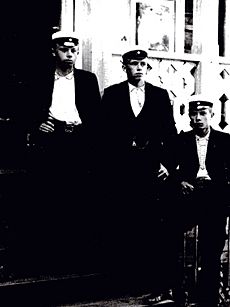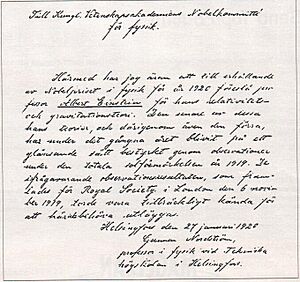Gunnar Nordström facts for kids
Quick facts for kids
Gunnar Nordström
|
|
|---|---|

Nordström at the age of 35
|
|
| Born | 12 March 1881 |
| Died | 24 December 1923 (aged 42) Helsinki, Finland
|
| Nationality | Finnish |
| Citizenship | Russian, Finnish |
| Alma mater | Helsinki University of Technology (Engineer), University of Helsinki (Master of Science, and PhD) |
| Known for | Nordström's theory of gravitation Kaluza–Klein theory Reissner–Nordström metric |
| Scientific career | |
| Fields | Physics, Mechanics |
| Institutions | Helsinki University of Technology University of Helsinki University of Göttingen University of Leiden |
| Academic advisors | Paul Ehrenfest, Walther Nernst (briefly) |
| Influences | Albert Einstein |
| Influenced | Albert Einstein, Rolf Nevanlinna |
Gunnar Nordström (born March 12, 1881 – died December 24, 1923) was a smart Finnish scientist. He was a theoretical physicist. He is famous for his ideas about gravity. These ideas were an early rival to Albert Einstein's theory of general relativity. People sometimes call Nordström "The Einstein of Finland." This is because he worked on similar science topics using similar methods as Einstein.
Contents
Becoming a Scientist: Education and Career
Gunnar Nordström finished high school in Helsinki in 1899. At first, he studied mechanical engineering and graduated in 1903. This was from the Polytechnic Institute in Helsinki. Today, this school is part of Aalto University.
While studying, Gunnar became very interested in more theoretical subjects. After getting his engineering degree, he went on to study for a master's degree. He focused on natural science, mathematics, and economics at the University of Helsinki. He finished this in 1907.
Studying in Germany and the Netherlands
Nordström then moved to Göttingen, Germany. He was supposed to study physical chemistry there. But he soon became more interested in electrodynamics. The University of Göttingen was well-known for this field.
He returned to Finland to finish his PhD at the University of Helsinki in 1910. After that, he became a docent at the university. A docent is like a special lecturer or researcher. He then became very interested in the new field of gravity. He wanted to move to the Netherlands to work with famous scientists there. These included Hendrik Lorentz and Paul Ehrenfest.
In 1916, Nordström moved to Leiden in the Netherlands. He worked with Paul Ehrenfest during World War I. He could travel because he had a Russian passport. In Leiden, he met Cornelia van Leeuwen, a Dutch physics student. They later got married and had children.
Returning to Finland
After the war, Nordström was offered a job as a professor at the University of Berlin. But he chose to return to Finland in 1918. He became a professor of physics at the Helsinki University of Technology. Later, he became a professor of mechanics there.
One reason for Nordström's success was his skill in using differential geometry in physics. This was a new way of thinking. Albert Einstein also used this method to create his theory of general relativity. Not many other scientists at that time could use this new tool so well.
Nordström's Ideas About Gravity and Space
During his time in Leiden, Nordström solved some important equations. These were Einstein's field equations for a charged object that is round like a ball. Other scientists like Hans Reissner also found this solution. Today, it is called the Reissner–Nordström metric.
Nordström often talked with other great physicists. These included Niels Bohr and Albert Einstein. For example, Bohr helped Nordström get his letters past Russian censors. Finland was then part of the Russian Empire.
Competing with Einstein's Theory
Nordström's theory of gravity was very famous during his lifetime. Many people saw it as a rival to Einstein's theory of general relativity. Einstein published his theory in 1915, after Nordström's.
In 1914, Nordström added an extra dimension to his theory of gravity. This extra dimension helped connect gravity with electromagnetism. This was one of the first ideas about "extra dimensions." Later, this idea became known as Kaluza–Klein theory. Kaluza and Klein published their work in the 1920s.
Nordström's ideas about extra dimensions became less known. This might be because some of his work was published in Swedish. Also, Einstein later mentioned only Kaluza in one of his papers. Today, scientists still study extra dimensions. They even look for them in experiments!
Why Einstein's Theory Won
Nordström's theory of gravity was later tested. It was found to be not as accurate as Einstein's. For example, Nordström's theory did not predict that light would bend around the sun. This bending was seen during a solar eclipse in 1919.
Even though their theories competed, Nordström and Einstein were friends. They even worked together sometimes. Nordström admired Einstein's work. He nominated Einstein for the Nobel Prize in physics two times for his theory of relativity. Einstein never won the Nobel Prize for relativity itself. This was because the early evidence was still debated. Also, the complex math was not fully understood by everyone yet.
Today, Nordström's simpler theory of gravity is often used to help students learn about general relativity.
Nordström's Legacy in Finland
Not many people today, even in Finland, know about Nordström's important work. But after he died, many Finnish physicists and mathematicians studied relativity and differential geometry. This was probably because of the ideas he left behind.
Personal Life and Death
Gunnar Nordström moved to the Netherlands when World War I started. There, he met and married Cornelia van Leeuwen. They moved back to Finland in 1918.
Nordström died in December 1923, when he was 42 years old. He died from a serious illness called pernicious anemia. This illness might have been caused by being around radioactive substances. Nordström was known for experimenting with radioactive materials. He also enjoyed the Finnish sauna tradition using water from a spring rich in radium. In 1913, he even published a paper about measuring the "radioactive power" of different springs in Finland.
See also
 In Spanish: Gunnar Nordström para niños
In Spanish: Gunnar Nordström para niños
- Nordström's theory of gravitation



